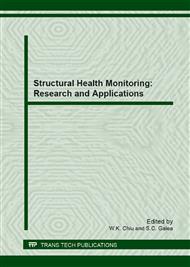p.477
p.489
p.501
p.510
p.522
p.534
p.546
p.554
p.561
Structural Seismic Damage Detection Using Fractal Dimension of Time-Frequency Feature
Abstract:
In this paper, a data-driven approach to localizing structural damage subjected to ground motion is proposed by using the fractal dimension of the time-frequency features of structural dynamic responses. The time-frequency feature is defined as the real part of wavelet coefficient and the fractal dimension adopts the box-counting method. It is shown that the proposed fractal dimensions at each story of linear system are identical, while the fractal dimension at the stories with nonlinearity is different from those at the stories with linearity. Therefore, the nonlinear behavior of structural damage caused by strong ground motions can be detected and localized through comparing the fractal dimensions of structural responses at different stories. Shaking table test on a uniform 16-story 3-bay steel frame with added friction dampers modelling interstory nonlinear behavior was conducted. The experiment results validate the effectiveness of the proposed method to localize single and multi seismic damage of structures.
Info:
Periodical:
Pages:
554-560
Citation:
Online since:
June 2013
Authors:
Price:
Сopyright:
© 2013 Trans Tech Publications Ltd. All Rights Reserved
Share:
Citation:


